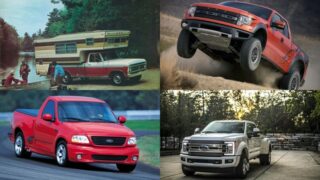12/03/2002 – New Dearborn Truck Plant Herals Era Of Lean, Flexible Manufacturing
| Source: Ford Motor Company |
|
NEW DEARBORN TRUCK PLANT HERALDS ERA OF LEAN, FLEXIBLE MANUFACTURING Flexible vehicle assembly and lean principles will reach new milestones at the Dearborn Truck Plant. The innovations being implemented will establish a new era in manufacturing, efficiency and workplace culture.” Anne Stevens, Vice President DEARBORN, Mich., Dec. 3, 2002 — When the new Dearborn Truck Plant (DTP) begins operations in 2004, it will be more than the home of the new 2004 Ford F-150. It will signal an expansion of the company’s manufacturing vision and the first major step toward making the legendary Ford Rouge Center an industrial icon of the 21st century. The plant will be the flagship of Ford’s next-generation lean and flexible manufacturing facilities.
Dearborn Truck Plant is a key example of Ford’s commitment to establish a next-generation flexible manufacturing system in its North American assembly operations. By mid-decade, about half of Ford’s body shops, trim and final assembly operations will be flexible. That number will rise to 75 percent by the end of the decade. The system is expected to save the company $1.5 billion to $2 billion in the coming decade. DTP’s flexible features include the ability to:
“With increasing market segmentation, Ford’s new flexible assembly system means the company can react more quickly to meet shifting customer demand,” said Al Ver, vice president, Ford Advanced and Manufacturing Engineering. “The company will be able to produce a wider variety of vehicles, change the mix of products and options, and change volumes – faster and with minimal costs.”
The Dearborn Truck Plant will have world-class lean manufacturing using Synchronous Material Flow (SMF) to support team-based production processes. These processes are designed to provide outstanding quality and minimize waste in a safe work environment that emphasizes employee empowerment. Vehicles will be manufactured at the lowest cost in the shortest time possible. “Quality is built in at each workstation based on these standardized work processes and a clear understanding of the customer’s expectation,” said Jay Richardson, Rouge project manager, Ford Vehicle Operations. Although many plants use SMF to synchronize vehicle and supplier production at the same rate of customer demand, the Dearborn Truck Plant will use a combination of material delivery systems. These include In-line Vehicle Sequencing and an Automatic Sequence and Retrieval system that are both designed to sequence units into a predictable schedule. This allows Ford suppliers to more precisely plan deliveries and allows the plant to optimize efficiency. As part of a new fast-paced delivery system, truck docks allow material unloading within a 15-minute window. Ford’s team-based organization delivers components to the line at the same rate as product flow and is committed to build to a specific schedule. By using proactive problem solving and a key element called In-Station Process Control, line operators have the responsibility for producing a product with no quality issues when it leaves their work cell.
All of these processes result in reducing the number of workstations in the assembly process by nearly 40 percent. Storage space for components and vehicles will be cut by 50 percent. The plant will have no more than two hours of line-side parts and inventory and 10 hours of off-line components. “The crux of the change is the way people work and they way machinery is organized,” said Anne Stevens, vice president, Ford North America Vehicle Operations. “Lean manufacturing is all about people and the way they use technology.”
The company utilized the expertise of plant operators at Dearborn Assembly Plant (DAP) who will transfer to the new DTP to help design the new workstations in final assembly operations. Since they know best what it’s like to work on the line, DAP operators and skilled trades workers have been working with DTP’s launch team on designing and testing standardized work cells and tools. Among their goals is to enhance quality, cut costs and promote employee safety. To create a lean and high-quality facility, empowered workers at DTP, and the other Ford plants, will have a continuing impact on how their jobs are done. Typically in a plant, supervisors manage operators. In Ford’s inverted pyramid system, operators work in teams of six to eight, with a team leader. Supervisors are manufacturing advisers, supporting the operators and their team leaders. Operators assume roles of responsibility and decision-making. Their motto: Zero defects. Zero waste.
One of the guiding design principles of the new plant is employee safety and comfort. In the Final Assembly building, mezzanine levels and overhead walkways will cut pedestrian traffic on the floor. The aisles will be wide (18-21 feet versus the usual 12 feet) and clear of parts or components. Forklifts will not be allowed in the production areas. The building’s design produces a clean, quiet and well-lit environment. Inside, an air-tempering system, aided by the living roof, will keep the interior at least 10 degrees cooler than the outside temperature in the summer and 10 degrees warmer in winter. Natural light from the 10 roof monitors and 36 skylights will flood the Final Assembly building’s 1.7 million-square-foot interior. The building also includes people-friendly features such as overhead safety walkways, team rooms and relaxing places to congregate. The plant will be quieter, because the noise of churning conveyors and whizzing pneumatic tools will be gone. Instead of unwieldy and noisy pneumatic gear, DTP will employ electric power tools. Ford has been a leader in ergonomics, and that continues to play a major role in the design of new jobs and tools. The new tools translate into less stress and strain on operator arms and wrists. In fact, very few operators will need to work with their hands above their heads or stoop to do a job below their knees. Operators will ride on skillets as they work. Skillets are individual pallets for every vehicle, and some are capable of adjusting to each operator’s height and work activities as the vehicle moves from work cell to work cell. “The new Dearborn Truck Plant will be a world-class facility that builds on our manufacturing legacy at the Rouge, one of the enduring symbols of the industrial age,” said Roman Krygier, group vice president, Ford Global Manufacturing and Quality. |




